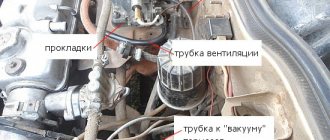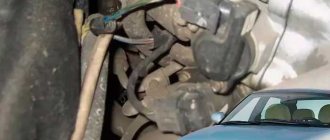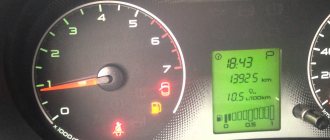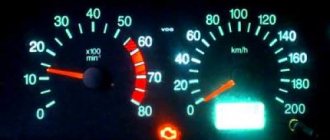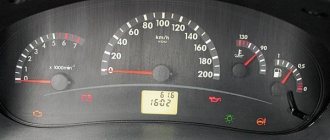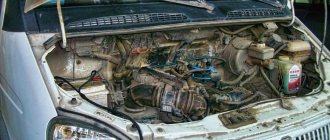Probably every car owner at least once in his life has encountered the problem of a stalling engine, and this can happen not only with domestically produced cars. So, some time ago, most drivers agreed that most often the engine stalled due to the technical features of the VAZ, however, as it turned out in practice, similar problems quite often occur on foreign cars. This means that it doesn’t matter at all whether your car is domestic or has a more “noble” origin - it is equally likely to stall at idle at the most inopportune moment.
The main reasons for engine stalling at idle
Before we begin to describe the main reasons why the engine stalls at idle, it is worth saying a few words about how this happens. You get into the car and start the engine, which functions as usual. But as soon as you take your foot off the gas pedal, a drop in revolutions is observed, although the idle speed sensor shows the nominal speed. At the same time, you can clearly hear that the engine is operating unstably, or even stalls completely. This is manifested by detonation of the propulsion system, which can cause very unpleasant complications.
It should be noted that when you start the engine again, the problem may not appear, and you can easily hit the road, but after a while the engine will stall again. That is why, after discovering the first malfunctions, you should immediately begin troubleshooting.
Almost every car owner has experienced engine stalling.
However, first of all, it is worth determining what exactly may be causing the incorrect operation of the power plant. As a rule, car owners and auto mechanics agree on the following main reasons why the engine may stall at idle:
- malfunction of the idle speed sensor or its complete failure;
- accumulation of dirt in the throttle valve;
- failure of the throttle position sensor;
- contamination of the carburetor or injector (depending on the type of car).
Of course, in some cases the problem may be more trivial: a misaligned battery terminal, an empty fuel tank, the use of low-quality fuel, etc. But we will not focus on them, since even an amateur car owner can solve these problems.
The causes of the malfunction in each individual case may differ radically, so you must be prepared to use various measures to eliminate them. As practice shows, experienced car owners are able to cope with the problem on their own, while beginners are better off immediately seeking the help of specialists.
Dirty throttle valve and pipes
From time to time the throttle valve becomes clogged, for example if the air filter is already in poor condition. Then it’s worth removing all the pipes from the throttle, checking them for permeability and blowing them out. It definitely won't be redundant.
Next, disconnect the throttle cable and wires and remove the throttle. The cleaner can be found at any auto store. In case of heavy contamination, take a clean container and soak the throttle valve in gasoline in it for some time. Don't be afraid to blow out absolutely everything, as the throttle has narrow channels that can also clog.
Are there any differences in uneven operation on the carburetor and injector?
The reasons for silencing of carburetor and injection engines are somewhat different. So, for carburetor engines, the most common causes are:
- Failure of the carburetor itself due to debris. To fix the problem, you just need to rinse and clean the carburetor.
- A clogged fuel filter, as well as a clogged fuel pump filter mesh, which also need to be cleaned of spent fuel and other dirt.
- Failure of hoses and various rubber connectors - you just need to replace them.
- Failure of the solenoid valve can be resolved by replacing it. To identify the problem, you need to turn on the ignition, remove the wire from it, and after a few seconds connect it again, and you should hear a characteristic click. If there is no click and the warning lamp lights up on the instrument panel, the valve is faulty.
- A clogged idle jet can be solved by cleaning it.
- In some cases, the problem may be associated with incorrect operation of the idle speed sensors, the location of the throttle valve, and the crankshaft.
The idle speed control and the idle speed sensor are not the same thing. In some models they can be combined into one non-separable mechanism, in others - separately
For injection engines, the most common reasons for engine stalling and a drop in speed are:
- Malfunction of the idle speed control.
- Insufficient fuel pressure or air leaks - to eliminate the problem, you need to clean the filters and also make sure that the connecting elements are tight.
- Failure of the vehicle's electronic systems, for repair of which it is recommended to contact a specialized service center.
- Problems in the operation of the mass air flow sensor, as well as malfunctions in the ignition system - the main reason is related to the spark plugs.
Fuel pump strainer is clogged
Considering the quality of fuel supplied to our market, you can often encounter a similar problem. If you have checked everything listed above, but still have not figured out the problem, it is better to immediately go to the nearest auto parts store and purchase a new mesh there. The issue price is about 70 rubles.
Then, under the rear seats, we find the hatch and unscrew it, gaining access to the gas tank. We disconnect all the tubes and remove the fuel pump mount and remove the entire mechanism from the tank. A mesh will be attached to the supply to the fuel pump, remove it and install a new one. Afterwards we collect everything back into the gas tank.
Reasons for stopping a warm engine and a cold one
Experts note that the reasons for stopping the engine when cold and hot are in most cases no different and can be caused by the following malfunctions:
- vacuum leak;
- failure of the distributor cap, rotor, ignition wires or spark plugs;
- incorrectly set ignition timing;
- incorrect operation of the vehicle's ECU (electronic control unit) system, which can only be identified by using a special diagnostic device;
- malfunction of the exhaust gas recirculation valve;
- the presence of mechanical damage to the engine, as well as excessive wear of its elements;
- contamination of fuel injectors;
- malfunction of the idle air control (this problem often appears on Kalina cars).
The reason why the engine stops when cold can be a vacuum leak, dirty fuel injectors, etc.
Spark plug
The main thing is that you cannot immediately determine why one of the cylinders failed. That is why even experienced car enthusiasts and experienced drivers can delve into the insides of their car all day long, but in the end they will not achieve any result. You have to check everything several times.
How can you speed up this procedure and pay attention to the most important problems. Most often, the engine stalls when warming up due to faulty spark plugs.
One of the causes of malfunction are spark plugs if:
- The contacts and insulation of the spark plugs are covered with oil or black soot.
- The spark plugs or their contacts are damaged.
The problem is this:
- excess oil enters the combustion chamber from the crankcase;
- the air-fuel mixture located in the combustion chamber does not ignite due to a faulty spark plug.
The solution to the problem is simple: you need to replace the entire set of spark plugs, and then check the remaining parts next to them for damage. Change the oil and start the engine. If the tripping has stopped, then everything has been done correctly; if not, we need to look for other sources of the problem.
Why is idle speed unstable on diesel and gasoline?
In most cases, there is no difference whether a gasoline or diesel power unit is installed in your car - the reasons for the engine stopping will be identical. In this case, it is recommended to inspect and clean the throttle valves, and also check the functionality of the idle speed and throttle position sensors. If the problem is not resolved, then most likely you will have to completely replace the failed equipment, which can be identified by contacting specialists for help.
Moreover, it does not matter whether the engine stalls periodically or regularly - the very presence of the problem indicates a malfunction that must be eliminated as soon as possible.
What to do first
You need to start with the simplest. Check if the system is sucking air from the joints, replace the lower canister hose, check the condition of the sensors, clean them, wash the throttle, check the mesh on the fuel pump - it may become clogged due to the quality of the gasoline.
It’s good if it is possible to carry out computer diagnostics at a service station. The devices make it possible to identify faults in individual parts of the machine not only more accurately, but also noticeably faster than with traditional methods.
Problems with sensors and other electronics
If you have a modern car, you should check the serviceability and settings of sensors and units. Such problems are often found using computer diagnostics. In a modern car design, correct operation of the sensors guarantees stable engine operation by 90%.
Electrical problems
On carburetors, the ignition timing setting may be lost. Regardless of the type of internal combustion engine, spark plugs, coils, relays and fuses fail or malfunction.
Mechanical problems
You should check:
- carburetor;
- throttle valve condition;
- fuel/air line;
- pumps;
- filter elements;
- wear of the cylinder-piston group.
If the problem cannot be found, you should contact a service station.
Diagnostic sequence
No specialist can give any precise recommendations on the diagnostic sequence, but if the problem of a suddenly stalling engine appears periodically, you can wait a little and try to determine under what circumstances it occurs. It would also be a good idea to visit specialized forums dedicated to the problems of a particular make and model of car.
To carry out the most accurate diagnostics, it is recommended to connect the car to a special diagnostic device, which can be found at any specialized service station.
How to check the wiring?
There is one, rather risky way to find the cylinder: disconnect the high-voltage cables from the running engine one by one. By disconnecting the power from the ignition, it will be possible to understand which of the cylinders is not working, thereby significantly narrowing the search.
However, there is a risk of electric shock. It is not fatal, but it is quite painful, so you need to take care of your protection. You can start working if you first put on rubber gloves and stand on a rubber mat. Then follow these tips:
- Turn on the engine, raise and secure the hood.
- One by one, you need to disconnect the cables from the spark plugs. You must hold on to the insulation, not the tip of the wiring; you must not touch the body while removing the live wiring.
- If you turn off the slave cylinder, you will hear that the sound of the engine running has changed. But if it is faulty, then nothing will happen.
Cars with gasoline engines
A gasoline engine may not start after warming up quite often, especially when operating in low temperatures. The fact is that the fuel remaining in the chamber begins to evaporate quickly due to elevated temperatures. Vapors fill all cavities, including the carburetor, manifold, and air filter. As a result, fuel levels in the float chamber decrease and gas plugs occur. The duration of this process depends on the design of the fuel system and on the external temperature conditions.
That is, the reason why a gasoline engine does not warm up after warming up lies in excessive evaporation of gasoline and the formation of an enriched fuel mixture.

